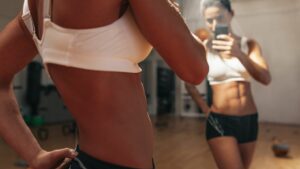In the intersection of fitness and fashion, a new breed of brands is emerging. They’re redefining what it means to be stylish while breaking a sweat, and they’re capturing the attention of fitness enthusiasts and fashionistas alike.
These brands aren’t just about looking good—they’re about performance, comfort, and durability too. They’re proving that you don’t have to sacrifice style for functionality or vice versa. Whether you’re a gym rat or an occasional yogi, there’s a fitness fashion brand out there that’s perfect for you.
Join us as we explore the world of fitness fashion brands, their rise to prominence, and why they’re a hit among today’s active and style-conscious consumers.
Fitness Fashion Brands
 With the increasing prevalence of fitness fashion brands, a number of trends have emerged that are worth noting. These trends reflect both the creative innovation and responsiveness of these brands to the evolving demands and expectations of active and style conscious consumers. An increase in the demand for greener products has prompted many fitness fashion brands to turn towards sustainable materials. Companies are using renewable resources such as bamboo for apparel. In fact, brands like Girlfriend Collective convert recycled plastic bottles into leggings, demonstrating their commitment to the environment. Brands like these strike the balance, using sustainable practices while ensuring their products are durable and endure vigorous activities. Promoting both style and sustainability, these brands have successfully carved a niche for themselves in the fitness fashion industry.
With the increasing prevalence of fitness fashion brands, a number of trends have emerged that are worth noting. These trends reflect both the creative innovation and responsiveness of these brands to the evolving demands and expectations of active and style conscious consumers. An increase in the demand for greener products has prompted many fitness fashion brands to turn towards sustainable materials. Companies are using renewable resources such as bamboo for apparel. In fact, brands like Girlfriend Collective convert recycled plastic bottles into leggings, demonstrating their commitment to the environment. Brands like these strike the balance, using sustainable practices while ensuring their products are durable and endure vigorous activities. Promoting both style and sustainability, these brands have successfully carved a niche for themselves in the fitness fashion industry.
Innovative Technology Integrations
 Moving beyond traditional clothing, some fitness fashion brands have delved into the world of tech integration. Brands are using technology to ensure their products provide superior comfort and improve the wearer’s performance. The use of moisture-wicking fabrics, temperature-regulating materials, and pressure-point cushioning is growing increasingly common. For instance, Under Armour’s line of HeatGear activewear includes a special fabric that wicks sweat and regulates body temperature. Such innovative use of technology has set these brands apart, aligning fashion with practicality, and driving customer attraction.
Moving beyond traditional clothing, some fitness fashion brands have delved into the world of tech integration. Brands are using technology to ensure their products provide superior comfort and improve the wearer’s performance. The use of moisture-wicking fabrics, temperature-regulating materials, and pressure-point cushioning is growing increasingly common. For instance, Under Armour’s line of HeatGear activewear includes a special fabric that wicks sweat and regulates body temperature. Such innovative use of technology has set these brands apart, aligning fashion with practicality, and driving customer attraction.
Without straying from the previous context and maintaining a coherent flow, the section covers the key trends in fitness fashion brands. These brands not only cater to fashion-conscious individuals but also address social concerns and utilize advanced technology for comfort and performance enhancement.
Popular Fitness Fashion Brands in 2023
 High-end fitness fashion brands in 2023 utilize advanced materials and innovative technologies, placing quality and comfort at the forefront. Lululemon, Nike, and Adidas, for example, offer time-tested reliability with their high-quality materials suitable for both rigorous workouts and casual wear. Known for their durability, these brands integrate temperature-regulating characteristics and moisture-wicking fabrics into their designs to assist peak performance.
High-end fitness fashion brands in 2023 utilize advanced materials and innovative technologies, placing quality and comfort at the forefront. Lululemon, Nike, and Adidas, for example, offer time-tested reliability with their high-quality materials suitable for both rigorous workouts and casual wear. Known for their durability, these brands integrate temperature-regulating characteristics and moisture-wicking fabrics into their designs to assist peak performance.
From Lululemon’s figure-flattering leggings to Nike’s innovative Epic React Flyknit running shoes, each product signifies a blend of style, functionality, and sustainability. Adidas also stays in the competition through its Parley collection, which incorporates recycled ocean plastic materials, manifesting an active commitment to the environment.
Affordable fitness fashion brands also play a critical role in the market landscape by providing consumers with cost-effective, yet stylish options. Brands like Gymshark, Under Armour, and Old Navy Athletic continue to make waves, attracting consumers with their reasonably priced products that do not compromise on style, quality, or comfort.
Impact of Social Media on Fitness Fashion
Social media plays a pivotal role in shaping fitness fashion trends and influencing consumer choices, as it provides a platform for brands to connect with customers on a personal level. Acknowledging the power of social media platforms in building brand awareness and fostering engagement, many fitness fashion brands are leveraging this medium to drive visibility and sales.
In the fitness fashion space, brands are increasingly resorting to influencer collaborations. Renowned influencers with large followings represent fitness fashion brands, offering authenticity and credibility to potential customers. Known personalities like Kayla Itsines with 12.7 million Instagram followers and Cassey Ho with 1.6 million YouTube subscribers are often seen sporting fitness clothing from brands, providing significant exposure. They showcase the wearability and function of these brands’ offerings in real, workout scenarios, significantly influencing their followers’ buying decisions.

